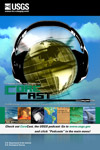USGS CoreCast
USGS Podcasts Home > CoreCast Home Page
Can't see Flash? Install Flash Player.
|
79
|

In this episode: California wildfires, the Great Southern California ShakeOut earthquake preparedness drill, landslide potential, and a magnitude 7.5 off the coast of Indonesia that prompts fears of a tsunami.
Type: audio/mpeg
File Size: 4426920 bytes Duration: 4:31 Released: Tue, 9 Dec 2008 12:31:19 UTC |
Transcript:
Welcome, and thanks for tuning in to the U.S. Geological Survey's Hazards Roundup for November 2008. My name is Brian Campbell, your host.
There was no shortage of hazards and hazard-related events to report on for the month of November. Even as fire fighters and emergency managers were responding to the latest blaze in southern California, millions of residents were participating in the largest earthquake drill in U.S. history! Then, just a week later, the arrival of torrential rains in the area was accompanied by concerns over potential flash floods and landslide activity! Elsewhere in the world, a large magnitude-7.5 earthquake off the coast of eastern Indonesia prompted fears of a major tsunami event. What happened? Let's get into it...
Wildfires continued to ravage southern California in mid-November. Major blazes fueled by powerful Santa Ana winds struck areas of Santa Barbara, Los Angeles, Orange, and Riverside Counties. Tens of thousands of residents fled for their lives as the fires destroyed hundreds of houses over several thousand acres. According to sources, the fire that struck the Sylmar section of Los Angeles on November 14 was responsible for the "worst loss of homes due to fire" ever in the City of LA, exceeding the losses incurred by a fire in Bel Air in 1961. It was only when the powerful Santa Ana winds receeded that firefighters and emergency responders were able to take control of the situation.
Even as the wildfires were burning in southern California, millions of residents were focused on other matters, namely, the inevitability of a major earthquake in the area in the next 30 years. On November 13 at 10:00am, over 5.3 million southern Californians dropped for cover and held on in the largest earthquake preparedness drill in U.S. history. The Great Southern California ShakeOut was deemed a huge success by the U.S. Geological Survey and its partners in the Earthquake Country Alliance, garnering national media attention and praise from the highest ranks of leadership, including Governor Schwarzenegger and Interior Secretary Dirk Kempthorne, both of whom participated in ShakeOut events. If you are interested in listening to Secretary Kempthorne and USGS Director Mark Myers share their thoughts on the ShakeOut, I encourage you to check out Episode 76 of CoreCast at www.usgs.gov/corecast.
Aside from the immediate threat of destruction posed by wildfires, these natural hazards are also capable of inviting the threat of landslide events. This occurs by way of the wildfires affecting soil chemistry in such a manner as to effectively break the soil down and make it more unstable. Consequently, when torrential rains began to fall in southern California during the week following the wildfires, evacuation orders were issued in Orange County, where landslide activity was deemed a probable threat to the residents there. Flash flood warnings were also issued elsewhere in southern California and rain fell at a rate of nearly one inch/hour in northern Los Angeles County. While the rain was welcomed in the parched areas, it was a subdued welcome at best due to the other natural hazard threats that it posed.
Elsewhere in the world, a massive earthquake struck off the coast of eastern Indonesia on November 16. Scientists at the U.S. Geological Survey determined the quake to be a magnitude-7.5. While no one was killed in the event, the quake and the large 5.4 and 5.5-magnitude aftershocks that accompanied it prompted officials at the National Oceanic and Atmospheric Administration to issue tsunami warnings in the area, spreading fear amongst residents that they would have to potentially relive an event such as the earthquake-induced tsunami in 2004 that killed over 200,000 people. Fortunately, the tsunami never came.
Well, that about wraps up November! Hazards Roundup is a product of the U.S. Geological Survey, Department of the Interior. I'm Brian Campbell, thanks for tuning in.


